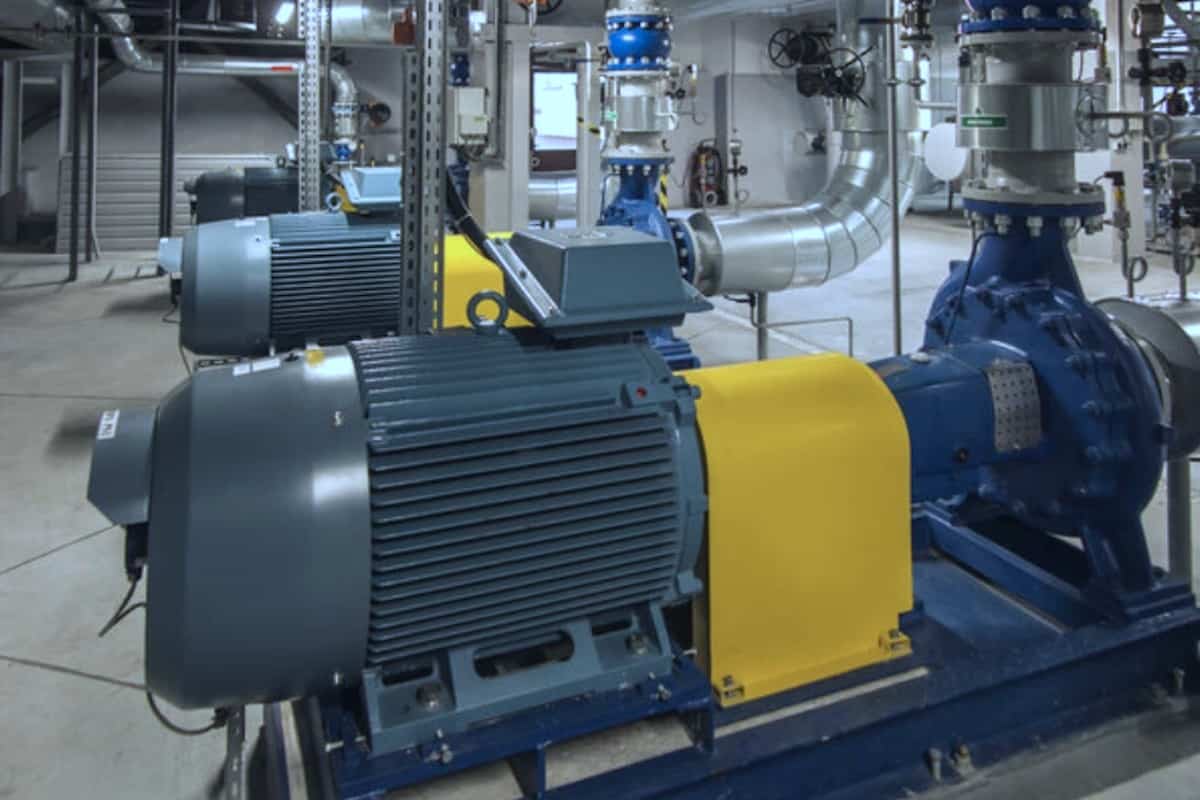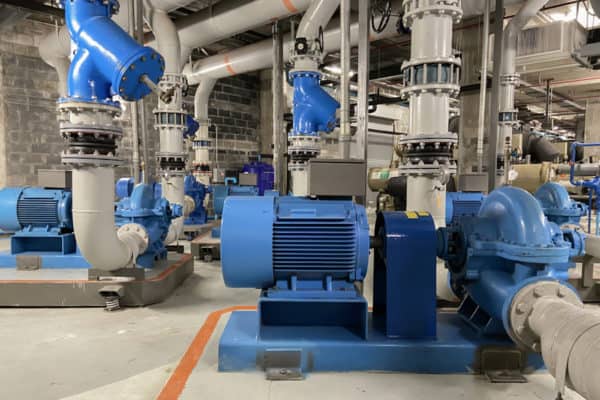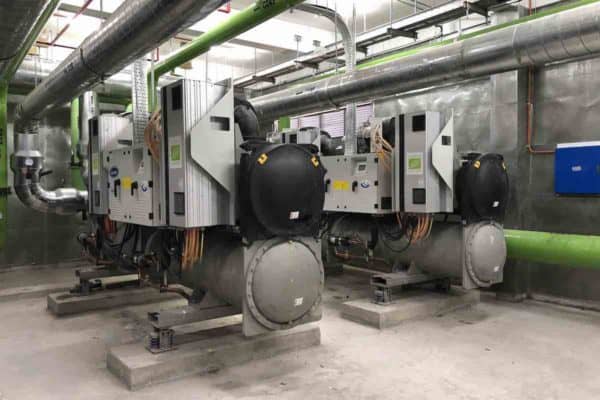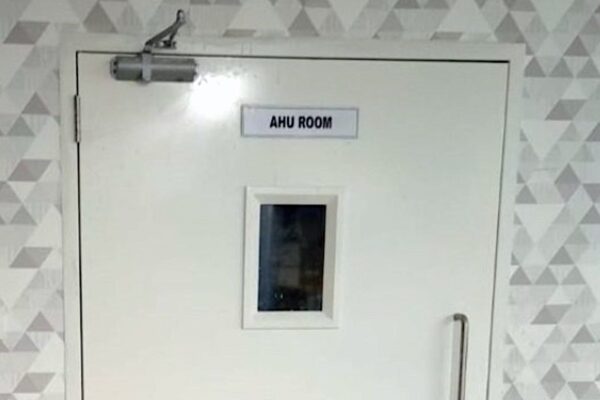Secondary Pump Chilled Water System Explained
Secondary pumps are very common in the chilled water system. Chillers require primary pumps to move water through their evaporators but why do most chilled water systems have secondary pumps? I’m curious. So, I spoke with a professional engineer about it.
Chilled water pumps of the chilled water system typically have two types of configurations; a) primary secondary pump configuration and b) variable primary pump configuration.
Many people including myself wonder why additional secondary pumps are used when chillers only need primary pumps to operate. Then, I found some interesting reasons.
Chilled Water Pump Configurations
Chilled water pumps are needed to circulate the chilled water in a closed-loop which includes chillers and air handling units. Although there are two configurations available, design engineers tend to use the primary secondary pump configuration.
Primary Secondary Pump
Most chilled water systems use the primary secondary pump configuration. As the name suggests, such a configuration involves a set of primary pumps and a set of secondary pumps.
Usually, one chiller is assigned with one primary pump. However, multiple primary pumps can be connected to a header before they are connected to the chillers so that they can be shared across the chillers.

Primary secondary pump configuration is a more simple approach to managing different cooling loads. The job of primary pumps is to make sure that the chillers are having the required water flow rate while secondary pumps are regulating the amount of chilled water supply to air handling units based on the cooling demand.
In the primary secondary pump setup, the speed of primary pumps is fixed. They can’t change their pump speed to regulate the chilled water flow rate through chillers.
On the other hand, the secondary pumps are variable speed. They have a variable speed drive to regulate their pump speed thereby controlling the amount of chilled water supply to air handling units.
When the cooling demand is low, secondary pumps can throttle down their speed thereby reducing the amount of chilled water supply to air handling units. Meanwhile, primary pumps continue to push the appropriate amount of chilled water through chillers thereby making sure that the chillers don’t trip due to insufficient water flow rate.
Chillers require a minimum water flow rate so that their evaporator doesn’t freeze up and the refrigerant evaporates appropriately. Otherwise, a safety device will trigger to stop the operation.
If the cooling demand continues to stay low, chillers and primary pumps will start to unload (gradually shut off) until the system is balanced. While doing so, secondary pumps continue to regulate the appropriate amount of chilled water supply to air handling units based on the cooling demand.
The primary secondary pump configuration separates the primary loop (chiller protection) and the secondary loop (cooling demand) clearly. Hence, the chances of having problems such as insufficient chilled water flow rate are greatly reduced.
Variable Primary Pump
Only a handful of chilled water systems use the variable primary pump configuration because it is much harder to perfect the control system.
Similarly, one chiller is usually connected to one primary pump. However, multiple primary pumps can be connected to a header before they are connected to the chillers so that they can be shared across the chillers.
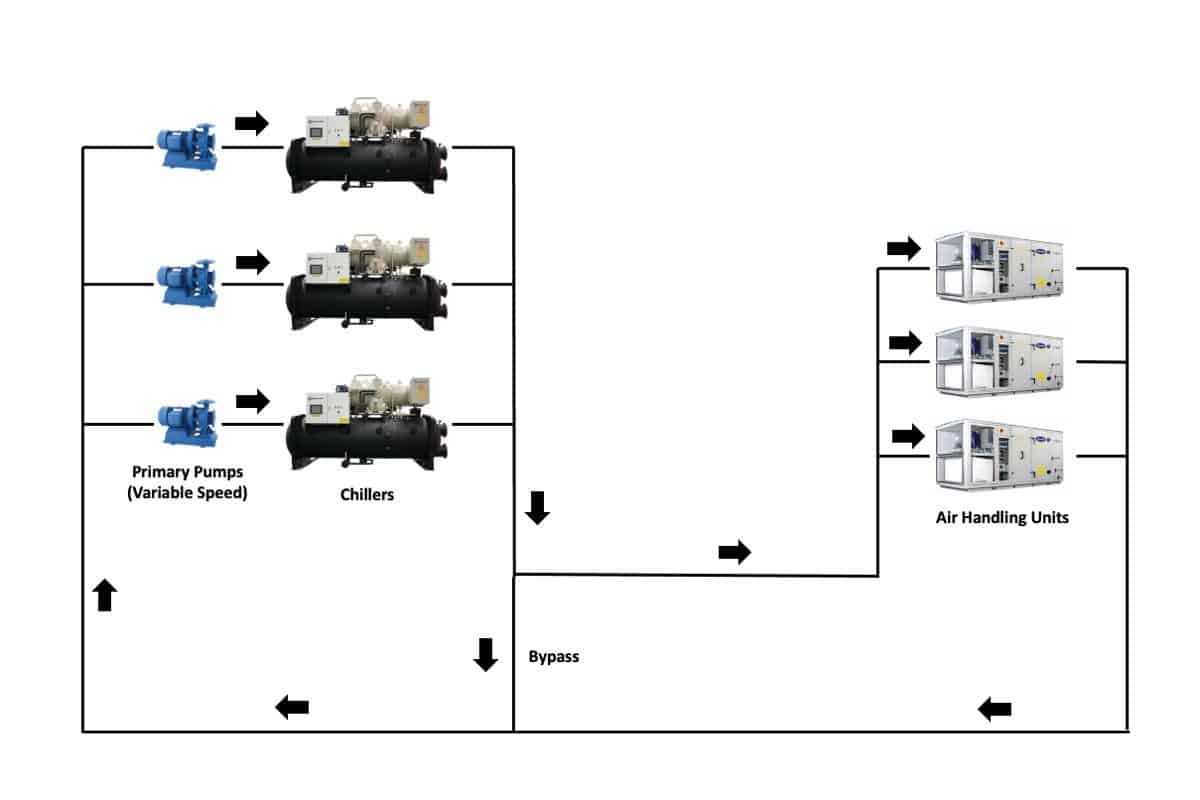
Only a set of primary pumps is present in this configuration. There are no secondary pumps involved in the chilled water system. Hence, the primary pumps are responsible for the operation of the chillers as well as the cooling demand.
As the name suggests, the primary pumps are variable speeds. They have a variable speed drive to regulate their pump speed thereby controlling the amount of chilled water flow through the chillers as well as through the air handling units.
Because the chillers and the air handling units have different chilled water flow rate requirements, precise control of the primary pumps is critical to the success of such a configuration.
During operation, the primary pumps must run at an optimal speed such that they prevent chillers from tripping due to insufficient water flow rate while trying not to oversupply chilled water to air handling units.
On one hand, the chillers require a certain flow rate to stay in operation. On the other hand, the amount of chilled water air handling units need varies based on the cooling demand.
The variable primary pump configuration combines the chillers loop and the air handling units loop. Thus, the primary pumps become a critical component.
On a side note, if you want to quickly learn about chilled water system, you can get my Chilled Water System (eBook). If you’re into design, you can enroll in my Chilled Water System Design Course where I teach you various design procedures with tons of examples.
Chilled Water System Design Course
Learn how to design a chilled water system with AHU/FCU selection, chiller sizing, cooling tower sizing, pump sizing, piping design, ductwork design and more.
Primary Secondary Pump vs Variable Primary Pump
The main reason why secondary pumps are used in most chilled water systems is that they are better at controlling the amount of chilled water supply to air handling units. Conversely, it is very difficult to master the control of the variable primary pump configuration.
As mentioned earlier, with two separate loops, the primary secondary pump configuration offers a simpler way to control the chilled water system. However, there are some drawbacks.
Firstly, chilled water systems that have only one set of primary pumps are cheaper to build and maintain. Besides, they occupy less space with the absence of secondary pumps and the associated valves and pipe fittings.
Secondly, the variable primary pump setup is more efficient because the total pressure drop is lesser and the total pump power consumption is lower. Furthermore, variable primary pumps are more likely to be running at optimal pump speeds.
However, as mentioned earlier, having only one set of primary pumps to handle two different water flow rate requirements is very challenging to perfect the control.
With an additional set of secondary pumps, it is easier to achieve both chillers’ water flow rate requirements and the air handling units’ water flow rate requirements based on the cooling demand.
Besides, having two separate circuits means that the troubleshooting and maintenance job is easier. Moreover, the primary secondary pump configuration is more popular and thus, more engineers and operators know how to run the system properly.
Common Problems with Primary Secondary Pump Setup
Although the variable primary pump configuration is harder to control, it is still appealing to many design engineers due to the problems with the primary secondary pump configuration.
At certain cooling loads, the primary pumps will supply too much chilled water, resulting in too much chilled water going through the bypass and mixing with the chilled water return. Ultimately, the chilled water returns back to the chiller at a lower temperature.
When the chilled water return temperature is low, the efficiency of chillers is low. However, the chillers can’t unload themselves because the cooling capacity will drop too much and cause insufficient cooling.
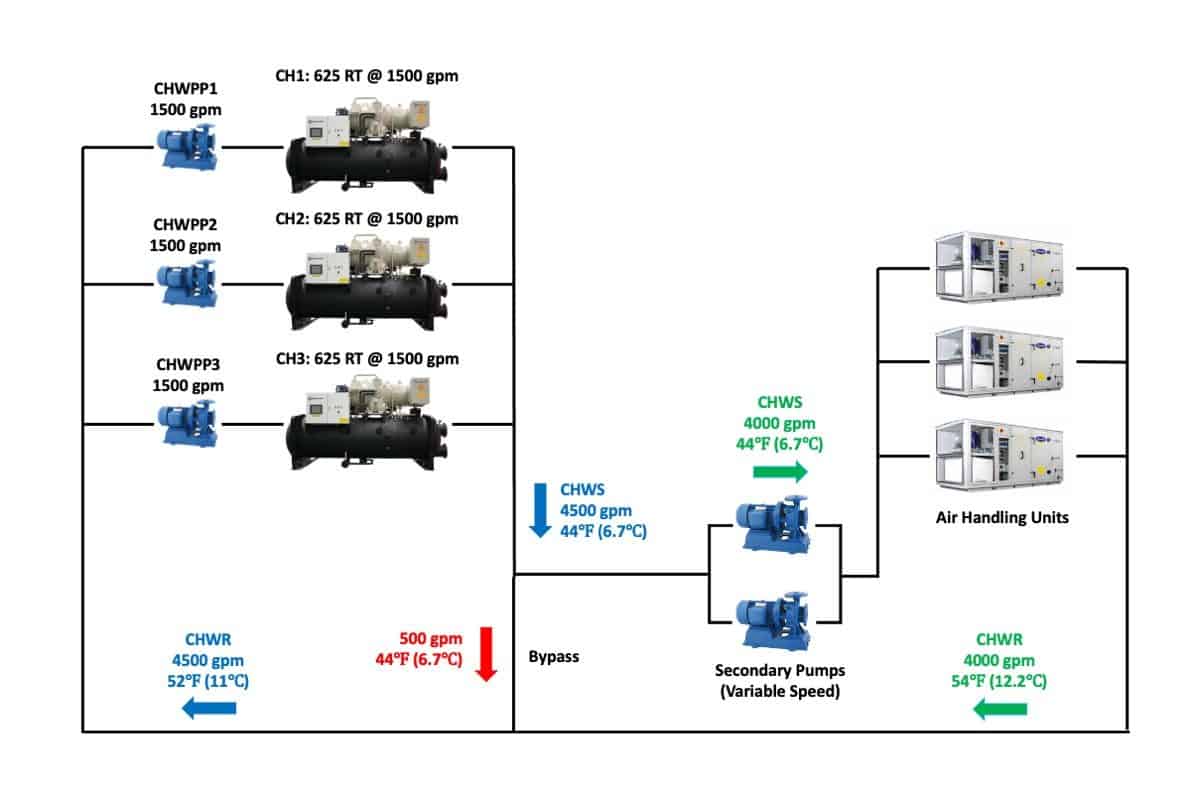
For example, let’s say we have three chillers with 625 RT @ 1500 gpm each. So, the total water flow rate is 4500 gpm. Since the primary pumps are fixed speed, there will be three scenarios:
- All three chillers are in operation and thus, the total water flow rate is 4500 gpm.
- Two out of the three chillers are in operation and thus, the total water flow rate is 3000 gpm.
- Only one chiller is in operation and thus, the total water flow rate is 1500 gpm.
Since the secondary pumps are variable speed, they can basically run at any water flow rate.
Now, let’s assume that the total cooling demand is 4000 gpm (~1650 RT). So, three chillers need to run simultaneously to produce 4500 gpm of chilled water at 44°F (6.7°C). But, the requirement is only 4000 gpm. Hence, 500 gpm of chilled water at 44°F (6.7°C) will go through the bypass.
With variable speed secondary pumps, the cooling demand is met perfectly. The chilled water returns at 4000 gpm at a temperature of 54°F (12.2°C).
However, because of the excessive chilled water production, the chilled water return back from air handling units has to mix with the chilled water coming through the bypass which is at 44°F (6.7°C) of temperature.
Consequently, the chilled water return temperature may become 52°F (11°C) which is lower than the design temperature of 54°F (12.2°C).
When the cooling demand is at 4000 gpm (~1650 RT), the system can’t shut down a chiller because it’ll then not be enough to meet the cooling demand. The same goes for 3500 gpm and 2000 gpm.
Consequently, too many chillers and primary pumps are running as well as too many cooling towers and condenser pumps are running.
In addition, chiller performance drops when the chilled water return temperature is low.
When the chilled water return temperature is low, the refrigerant evaporating temperature decreases and thus, the refrigerant evaporating pressure also decreased.
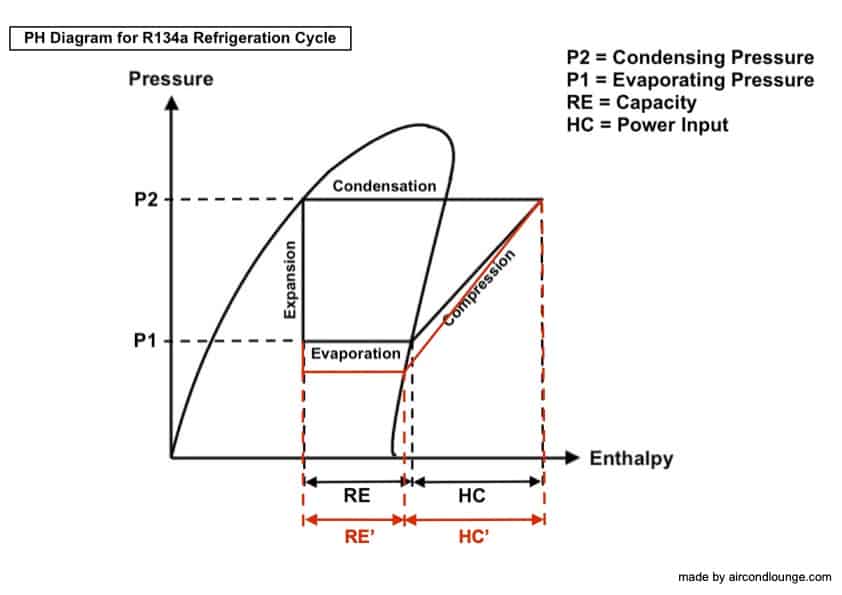
From the above PH diagram, we can see that by lowering the refrigerant evaporating pressure (P1), the refrigeration effect (RE) is shortened and the power consumption (HC) is stretched longer.
Since the coefficient of performance (COP) equals the refrigeration effect (RE) divided by the power consumption (HC), lowering the refrigerant evaporating pressure (P1) will result in a poorer COP.
However, there are ways to mitigate misaligned cooling capacity issues. Some of the solutions are multi-stage capacity chillers and variable compressor chillers. Still, the primary secondary pump configuration is more prone to low chilled water return temperature problems.
Conclusion
Having secondary pumps in the chilled water system reduce the complexity of the control system. However, the initial cost is higher and more space is needed. On the other hand, experienced engineers and operators are needed to build and run the chilled water system with variable primary pumps.
Nonetheless, both configurations have their own pros and cons. Therefore, we should always design the chilled water system based on what is best for our clients.
I have an extensive blog post on chiller performance and chilled water temperature. It’ll further elaborate on how chilled water temperature affect chiller performance. Do check it out.
Once again, you can get my Chilled Water System (eBook) to quickly learn more about chilled water system. But, if you want to learn how to design a chilled water system from start to end, I encourage you check out my Chilled Water System Design Course.
Chilled Water System Design Course
Learn how to design a chilled water system with AHU/FCU selection, chiller sizing, cooling tower sizing, pump sizing, piping design, ductwork design and more.
If you have anything to add (or ask) about this topic, leave a comment down below!


